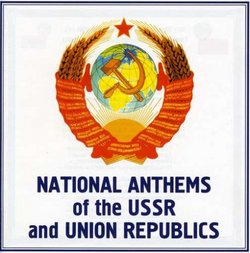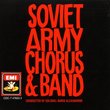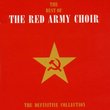| All Artists: Aleksandr [Piano] Aleksandrov, A/ Tychina, P./ Bazhan, M. Lebedinets, Mikhail Matveyevich Sokolovsky, M. Burkhanov, M. / Brusilovsky, E. / Khamidi, L. Tulebaev, Otar Vasil'yevich Taktakishvili, Uzeir Hajibeyov, Balys Dvarionas, Eduard Lazarev, A. Lepin, Vitaly Vlasov, S. Yudakov, Aram Khachaturian, V. Mukhatov, G. Ernesaaks, Yuri Simonov, Rauf Abdullayev, Fuat Mansurov, Georgia Symphony Orchestra, USSR Ministry of Culture Symphony Orchestra Title: National Anthems of the USSR and Union Republics Members Wishing: 0 Total Copies: 0 Label: Boheme Release Date: 1/30/2001 Genres: International Music, Pop, Classical Styles: Europe, Eastern Europe, Far East & Asia, Opera & Classical Vocal, Historical Periods, Classical (c.1770-1830) Number of Discs: 1 SwapaCD Credits: 1 UPC: 402410811663 |
Search - Aleksandr [Piano] Aleksandrov, A/ Tychina, P./ Bazhan, M. Lebedinets, Mikhail Matveyevich Sokolovsky :: National Anthems of the USSR and Union Republics
 | Aleksandr [Piano] Aleksandrov, A/ Tychina, P./ Bazhan, M. Lebedinets, Mikhail Matveyevich Sokolovsky National Anthems of the USSR and Union Republics Genres: International Music, Pop, Classical
|
Larger Image |
CD DetailsSimilar CDs |
CD ReviewsAnthems from a vanished country Andrew G. Lang | Cleveland, OH USA | 05/13/2004 (4 out of 5 stars) "In the former Soviet Union, each of the 14 "Union Republics" (with the exception of the Russian Soviet Federated Socialist Republic) had its own "national anthem." This collection--by Soviet-era orchestras and choirs--is the only one of its kind. All of the former SSRs (Soviet Socialist Republics) are represented, along with the famous USSR anthem which was banished for a time under Boris Yeltsin but now (with new lyrics) lives again as the anthem of the Russian Federation.
The music represents the ethnic and cultural diversity of the Soviet Empire: the heroic melodies and broad harmonies of the USSR and Ukrainian anthems reflect the expansive gestures of Orthodox church music; the Georgian anthem draws from the dissonant harmonies of Georgian sacred and folk music; the Armenian anthem, by the famous Soviet-Armenian composer Khatchaturian, has the Middle Eastern feeling of the Armenian folk idiom. The lyrics--which unfortunately are not translated--are typically bombastic. Verses expressing fealty to the "Party of Lenin" and praising the inspiring example of the "Great October" are normative. The word "glorious" appears to be inescapable. If you want a feeling for this style, check out the translations of the old USSR anthem available on the web. Apart from their origins in different folk idioms, the musical styles tend to range from militant (Armenia and Azerbaijan) to sentimentally lyrical (Latvia and Lithuania). The Latvian anthem, in fact, is unique in this collection because it is the only one in which (without knowing the words) it is difficult to imagine that you are striding confidentially into the future in unity with the Party of Lenin following the heroic example of the Great October. Instead, the melody seems to evoke the quiet villages, rolling hills and gentle beaches of this small Baltic country. In contrast, the anthems of the Soviet Central Asian Republics are close in musical spirit to the score of any of Cecil B. DeMille's blockbuster Hollywood costume dramas. One can visualize hordes of heroic Kyrgyz, Uzbek or Turkmen horsemen sweeping across the dusty plains of Asia ... all in the name of socialism, of course. Each of these anthems suffered a different fate after the USSR disappeared from history. The countries with the strongest national traditions (the Baltic states and Ukraine, for instance) restored older pre-Soviet anthems. Other republics retained the Soviet-era melody but wrote new lyrics. That was true especially of republics where the old Soviet nomenklatura still hold power: Belarus and Kazakhstan, for instance. Sadly, Armenia got rid of Khatchaturian's stirring composition: the music was, perhaps, too militant--and too confident of a glorious future--for a postmodern world." |

 Track Listings (15) - Disc #1
Track Listings (15) - Disc #1

